COVID-19’s global rampage causes turmoil for mining commodities

Gold nuggets isolated on black background.
With COVID-19’s rampant global spread shaking up finance and oil markets, investors have again turned to gold as a safe haven, but what’s happening with some other major commodities?
Probably the most negatively impacted commodity at the moment, with the market in oversupply and COVID-19 reducing demand is oil.
Global demand for the commodity has sunk amid the COVID-19 outbreak which has caused travel bans and restrictions, as well as a scale-back or complete shutdown of manufacturing and other operations.
Adding to the situation is a production stand-off between Saudi Arabia and Russia, with both countries entering a price war.
Meanwhile, the Organization of Petroleum Exporting Countries (OPEC) has been unable to get oil producing nations on the same page regarding cuts to alleviate the glut.
As a result, oil crashed more than 30% after the market opened on Monday to hit US$31.02 per barrel on Brent crude futures – its lowest in more than four years.

By Thursday market close, Brent oil was trading at US$32.70/bbl.
Gold
While oil and global stock markets flail in COVID-19’s wake, gold’s reputation as safe haven has been reinforced yet again.
Between September and November last year, the precious metal’s price hovered around A$2,200 per ounce, before dropping under A$2,150/oz in November and settling around that mark through to January.
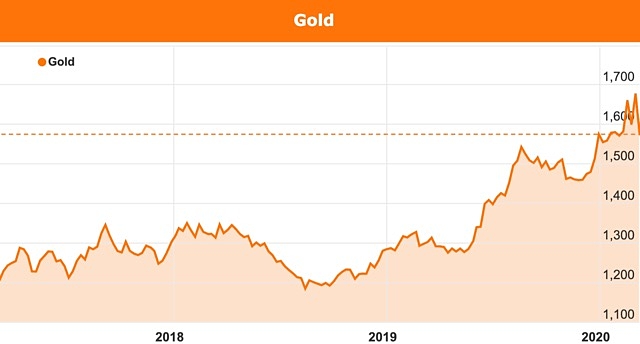
Driving the decline was improving sentiment in the markets and a firming Australian dollar.
Additionally, after a partial trade deal was struck between feuding US President Donald Trump and China’s President Xi Jinping, the outlook for other metals and markets lifted.
However, in January, the uncertainty caused by COVID-19 reared its ugly head and sent investors scrambling back to the metal where the price has surged from a little over A$2,150/oz to a high of A$2,560/oz on Monday.
Silver
Silver which is often referred to gold’s sister metal has also enjoyed an upward ride – albeit, a somewhat more volatile one.
The metal’s price has lifted from a low of just over A$24/oz in December to A$28.60/oz in late February.

It has since declined to trade at A$25.36/oz late Thursday.
Copper
Although 2020 was anticipated to be copper’s year for a comeback, yet another road block was placed in the commodity’s way with COVID-19’s spread causing prolonged shut downs at manufacturing plants across China and sluggish demand as the world anxiously awaits the virus’s full onslaught.
As a result, London Metal Exchange copper inventory has begun to build again to almost 190,000t – up from less than 125,000t in mid-January.
The rebuild in inventory and ongoing uncertainty with COVID-19 pushed copper’s price to US$5,482 per tonne on Monday – its lowest point in almost three years.
By Thursday, the metal’s price had crawled off the bottom to trade at a still subdued U$5,551/t.
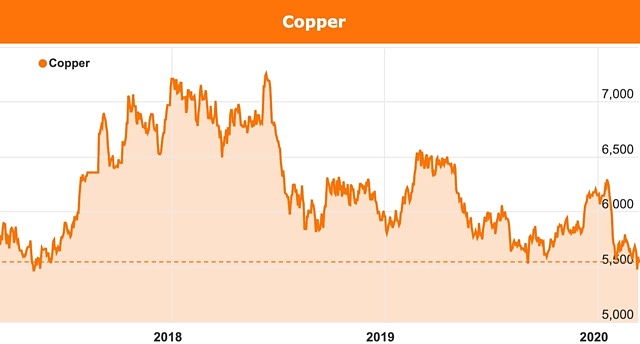
For the last few the ongoing trade dispute between the US and China has kept copper’s price artificially restrained, along with other base metals including nickel.
It appeared copper was finally going to get its break in 2020 after the partial trade resolution was secured last year.
The metal’s price had begun to recover – reaching US$6,275.5/t in mid-January before coronavirus fears took a foothold and unravelled its revival.
Nickel
Nickel is another commodity previously touted with a positive outlook for 2020 as supplies erode and demand increases.
Despite the tight market, COVID-19 manufacturing shutdowns have resulted in reduced consumption and increased uncertainty.
This has prompted nickel inventories on the LME to climb from 156,378t at the start of January to end February at 235,368t.
Similar to copper, as nickel inventory grew, the commodity’s price fell – hitting US$12,155/t on 28 February – down from US$14,285/t in mid-January.
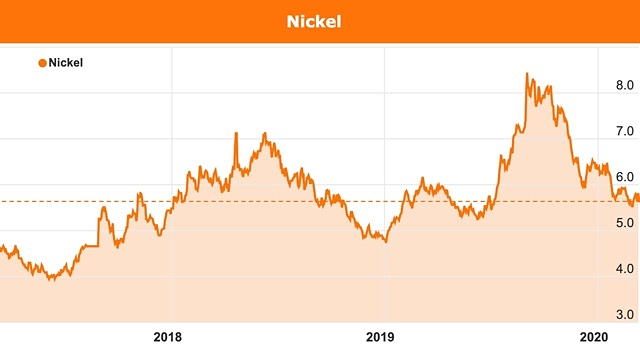
The dire supply situation for nickel has been somewhat reprieve in recent days with supplies eroding slightly this week to 234,666t.
Despite a wobble on Monday where the price fell to US$12,410/t, nickel lifted and was last trading at US$12,430/t.
Zinc
Demand for zinc took a bit longer to respond to the impact of the COVID-19 outbreak, with LME zinc inventory declining from 51,125t on 2 January to 49,625t in early February.
However, there was a substantial jump in inventory levels as February progressed, with levels hit 75,275t by the end of the month, before dipping slightly to 75,225t this week.
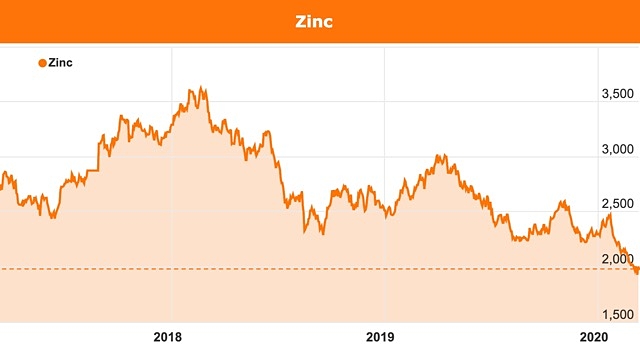
Following a similar pattern to other base metals, zinc’s price plunged from US$2,466/t on 22 January to a low of US$1,925/t on Monday.
There was a small bounce back on Tuesday, with the commodity’s price lifting to US$1,999/t. However, by Thursday it was trading at US$1,978/t.
Lead
Lead followed the lead of other base metals with LME inventory steadily rising from 66,100t at the start of January to close out February at 68,100t and reaching 70,300t by 11 March.
After starting 2020 on a sluggish note, the metal reached a high of US$2,026/t on 16 January before plunging to US$1,809.5/t in mid-February.

Since then the lead price has been quite volatile and was last trading at US$1,812.50/t.
Cobalt
Battery mineral cobalt is also traded on the LME, with the metal paving its own path over the last two months.
Despite the coronavirus headwinds, cobalt LME inventory has dipped from 668t on 2 January to 645t on Thursday – indicating demand has continued somewhat.
However, the metal’s price hasn’t fared as well – attracting US$31,000/t on Thursday after a volatile two months.
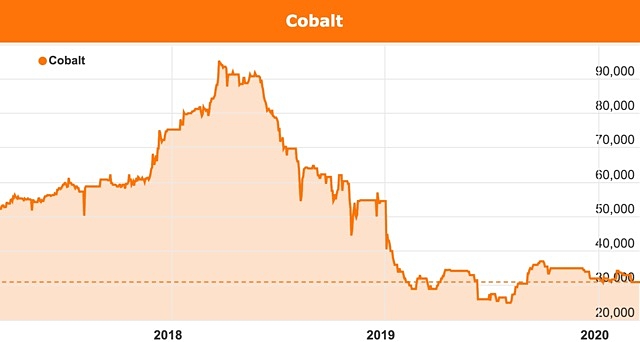
It started January at US$32,000/t and managed to spike at US$34,250/t in early February before beginning to decline.
Lithium and graphite
Other battery metals including graphite and lithium are bought and sold based on individual agreed prices between producers and offtake parties.
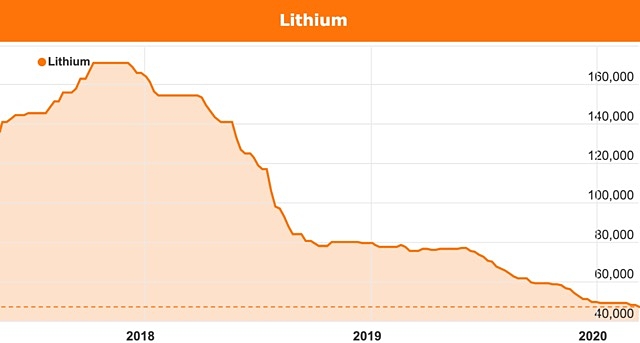
LME currently uses Fastmarkets’ price for lithium chemicals as a reference but there has been no change in the lithium carbonate weekly price since February which is currently US$8.75/kg. Likewise, the Fastmarkets reference price for lithium hydroxide is unaltered over the same period, with the chemical attracting US$10.25/kg.
COVID-19
COVID-19’s rapid spread has spooked already shaky global markets. Governments worldwide have been on the backfoot attempting to contain and prevent the spread of the virus while keeping business ticking over.
After bearing the brunt of the worst bushfire season on record, Australia was already reeling prior to the virus taking its global foothold.
In an attempt to mitigate the fall-out from both disasters, the Reserve Bank of Australia pared back the country’s official interest rate to a new low of 0.5% last week.
The bank also intimated more cuts could be coming to prop up the economy.
With that failing to halt the red tide, Australian Prime Minister Scott Morrison announced on Thursday new stimulus measures in attempt to ward off the looming recession.
The government revealed a A$17.6 billion plan to shore up Australia’s economy, with the stimulus’ objective of “keeping Australians in jobs” and businesses afloat.
Small and medium businesses will receive almost $12 billion of that in the form business investment support and cash flow assistance.
However, the government has allocated $4.8 billion in the form of a one-off stimulus payment to low income earners including pensioners and social security recipients.
Over in the US, stimulus measures and rate cuts have also been rolled out.
Additionally, US President Donald Trump revealed on Thursday a travel ban had been extended to prevent non-American citizens from European countries entering the US for 30 days.
On Thursday, Australia had 126 confirmed cases of the virus, while the World Health Organisation put the latest global infection rate at 125,048 cases and 4,613 deaths.
Near-term outlook
Speaking with Small Caps, Shaw and Partners WA state manager Davide Bosio said the current situation in base metals is a reflection of the “significant sell-off” happening in global markets.
He said right now, while we are in the middle of the cyclone, it is difficult to determine how big the economic pullback will be and when a recovery will begin.
However, Mr Bosio said the recovery will take its lead from China as it re-emerges from the destruction COVID-19 has caused.
Any improvement will be dependent on an increase in consumption and re-start in manufacturing across China and other parts of the world.
“As certainty returns, you will see that flow through to other market sectors including base metals.”
Although a recovery in base metals is anticipated, gold’s dominance as a safe haven isn’t expected to die off as the world recuperates from the rampant virus.
With global economies already in a fragile state, the virus’ full impact is yet to be seen.
Mr Bosio said recent rate cuts and government stimulus measures will continue to drive the gold price upwards.
Despite a potential global recession, Mr Bosio pointed out that historically markets always recover after a “significant event”.
“History will tell us that at some point, the markets will steady and recover over time.”
To get the latest commodity and market prices visit our market data page and click on the row to open the chart.
